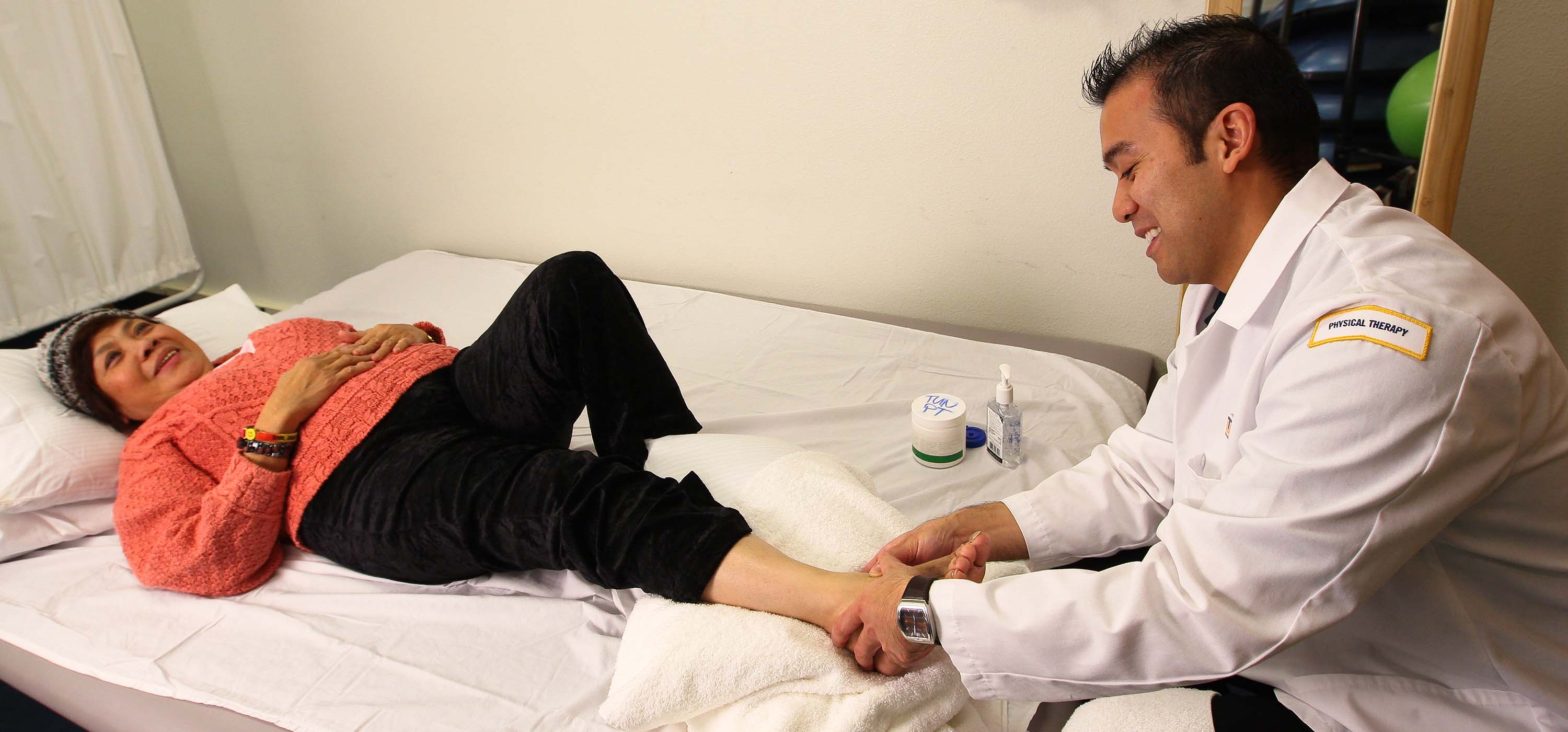
Former Actors Helping to Train Next Generation of Doctors and Healthcare Providers at Touro University Nevada
A few times each week, Beverly Washburn and Kerstan Szczepanski can be found acting as standardized patients for students at Touro University Nevada.
Inside one of the 11 exam rooms inside Touro’s Objective Structured Clinical Experience (OSCE) lab, Washburn complains about certain symptoms or asks for prescription drugs. It’s up to the student to properly assess the situation.
Washburn has had a lifetime of experience for this job as one of the most notable child actresses of the 1950s. But acting as a patient, she added, is one of the best roles she’s ever had.
“Working as a patient, we have to put ourselves in character and act how we might feel if these students were really our doctors,” Washburn said. “This is such a wonderful program that Touro University Nevada provides for its students because they learn how to make their patients feel important. They might see 50 patients in one day after they graduate, but each patient wants to feel like they’re the most important.”
Touro is the largest medical school in the state of Nevada and has approximately 30 standardized patients from a variety of backgrounds in feature film, TV, commercials, theater, and more. All of them work with students from the College of Osteopathic Medicine, as well as Touro’s Schools of Physician Assistant Studies, Nursing, Physical Therapy, and Occupational Therapy.
Now 75, Washburn has spent the last 70 years of her life as a working actress. When she was 6-years-old, the Southern California native landed her first role in the 1950 film “The Killer That Stalked New York,” featuring Evelyn Keyes and William Bishop.
“I actually died of smallpox in that role,” she said with a laugh. “And here I am at Touro playing a patient.”
Washburn has died in more than one of her roles throughout her storied career. In 1967, she played Lt. Arlene Galway during the second season of the original “Star Trek” series. In the episode, titled “The Deadly Years,” Washburn’s character died of old age as after contracting a radiation sickness.
“Funny enough, ‘Star Trek’ didn’t really start to become popular until after it ended,” she said with a laugh.
It was the Star Trek connection that first put Washburn in contact with Szczepanski, who came to Las Vegas after obtaining his theater degree from Northwestern University.
Szczepanski played the Cowardly Lion as part of the MGM Grand’s ‘Wizard of Oz’ theme when it opened in 1993, but he found his dream role in 1998 when “Star Trek: The Experience” opened inside the Westgate, formerly known as the Las Vegas Hilton.
“I was one of the first two actors they hired for the show,” he said. “I began my Star Trek career in Star Fleet where I would bring people onto the ride. Eventually, I went on to work as an Andorian.”
Growing up in Long Island, N.Y., Szczepanski was raised on Star Trek. When he was 10, he went as an Andorian for Halloween.
“When I got the job at Star Trek: The Experience, I was basically living my childhood dream,” he said.
Once the show closed its doors in 2008, Szczepanski found himself looking for work. It was at the annual Star Trek Convention shortly after when he first met Washburn. He remembered her from her role as Lt. Arlene Galway in the original series, and as fate would have it, the two would later work together as standardized patients at Touro University Nevada.
“Using the skills that I’ve developed as an actor is hopefully helping to make the students better healthcare professionals,” he said. “I’m in awe of how hard they work on a daily basis.”
Dr. Ronald Hedger, Associate Professor in Touro University Nevada’s College of Osteopathic Medicine, said working with standardized patients will help students become more comfortable in their environment once they go on their rotations.
All standardized patients are emailed their scripts a week before they perform their respective roles. The scripts are written by the primary care physicians in Touro’s College of Osteopathic Medicine, and usually cover the material that students are learning in class at that time.
“The actors are able to take on roles that students would expect to see in an urgent care, emergency room, or family practice setting,” Hedger said.
Hedger, who’s been on the Touro faculty since the university opened in 2004, helped start the patient-actor program with just 11 actors in 2005. While the university has since tripled the amount of patient actors it uses, expansion of the medical school and physician assistant studies program means they’ll need even more, he said.
Most standardized patients tend to range in age from the 40s-60s, though Hedger would like to include younger patient actors to help diversify the talent pool even more.
A typical standardized patient encounter lasts for 14 minutes, with another nine minutes scheduled for the students to complete their notes following the visit.
While students conduct their patient visits, Hedger and other Touro faculty watch and listen to every interaction from the OSCE lab’s control room. Each interaction is recorded and stored digitally, so students can watch their patient visits to see how they performed and what they can improve on for the next one.
“The patient actors have been a very important part of our education. They allow us to step outside of our role as a student and allow us to feel more like an actual physician,” said Mehdi Talle, a first-year medical student at Touro. “There are so many benefits to working with the patient actors, and I can’t speak highly enough about how great that experience is.”
Washburn said having a friendly and comforting demeanor is an important quality for the students to possess.
“If doctors don’t have that comfortable bedside manner and ability to connect with their patients, it can be very difficult,” she said. “What we try to do is give the students suggestions to help them improve on the little things to convey that warmth and passion.”
Hedger said the actors will sometimes have ‘debriefing sessions’ in order to provide students with the necessary feedback, though they never break character during the actual visit.
To make the visits more realistic, the patient actors each have a different backstory that portrays a different home life, a representation of the diverse patient population students will see once they graduate.
“In real life, not everybody is happily married with two kids, a dog, and a white-picket fence. There are all kinds of scenarios these students need to deal with,” Washburn said. “They’re going to have patients who are belligerent, crude, and nasty. They’ll also have the sweet ones or the ‘Whoa is me’ ones. Sometimes, they’ll get the patients who are only looking to get prescription drugs. So, when we get our script, its’ really fun to prepare for our role.”
Whatever the scenario calls for, Washburn is ready. Since she was a child, she’s been known for her ability to cry on command, an important trait when it comes to certain patient visits.
Washburn’s most notable role came in 1957 when she played Lisbeth Searcy in Walt Disney’s classic, “Old Yeller.”
“‘Old Yeller’ is more than 60 years old now, and unfortunately almost everybody from that movie is gone,” she said. “Actually, Old Yeller’s real name was ‘Spike,’ and they had gotten him from an animal shelter. They trained him to do everything. When the studios did other movies that featured dogs, they would use several different ones throughout the films. But, Spike did everything as Old Yeller.”
Szczepanski made the joke that he works as an actor because he’s lazy, though he’s in awe of the work ethic and determination the students display.
“I come to Touro and I see these kids busting their butts. It’s incredible,” he said.
Szczepanski and Washburn said first-year students are usually the most nervous, but they get better with more experience.
“We’ve grown to know and love these students, because we’ll see some of them as long as three years,” Washburn said. “We feel very fortunate to have this job because we want to help them even in the smallest way.”
Throughout the 1960s and 1970s, Washburn continued to work in TV, including “The Patty Duke Show,” “Gidget,” and “The Streets of San Francisco,” starring an up-and-coming Michael Douglas.
While she now works in a completely different capacity as a standardized patient, she’s just grateful to work with her fellow actors and actresses as they help train the next generation of doctors and healthcare providers at Touro.
“We really are like a family, and we love this job so much,” she said. “These students are our future, and if we can do just one little thing to help them, then we’ve done our job.”



